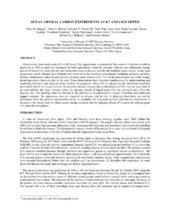Ocean abyssal carbon experiments at 0.7 and 4 km depth
Haugan, Peter Mosby; Brewer, Peter G.; Peltzer, Edward T.; Walz, Peter; Aya, Izuo; Yamane, Kenji; Kojima, Ryuji; Nakajima, Yasuharu; Nakayama, Noriko; Hove, Joakim; Johannessen, Truls; Bellerby, Richard G. J.; Alendal, Guttorm
Journal article
Permanent lenke
https://hdl.handle.net/1956/1164Utgivelsesdato
2005Metadata
Vis full innførselSamlinger
- Geophysical Institute [1198]
Sammendrag
Observations from small-scale (20 to 90 litres) CO2 experiments conducted off the coast of California at 684 m depth and at 3942 m depth are discussed. In both experiments, when the seawater velocity was sufficiently strong, parcels of liquid CO2 were torn off and transported away as discrete units by the turbulent water current. In the deep experiment, newly formed frazil hydrate was observed at the interface, occasionally including sediment particles. Hydrate furthermore collected and created a floating consolidated solid ("ice") in the downstream end of the trough, dissolving slowly from one day to the next. These observations have important implications for understanding and modelling of larger scale disposal at the seafloor. In particular, when CO2 is released by the interfacial instability mechanism driven by strong currents, the seawater density increase due to dissolution of CO2 may not have time to act and stabilize the water column before the discrete parcels of liquid phase CO2 are advected away from the disposal site. The floating solid that formed at the interface is hypothesized to consist of hydrate and additional trapped seawater. Its appearance was not expected in advance and its role in delaying dissolution can not be determined from the present experimental set-up. A capability for long-term seafloor perturbation experiments is deemed to be crucial both for direct ocean-storage research and for studying effects of invasion of anthropogenic CO2 from the atmosphere.
